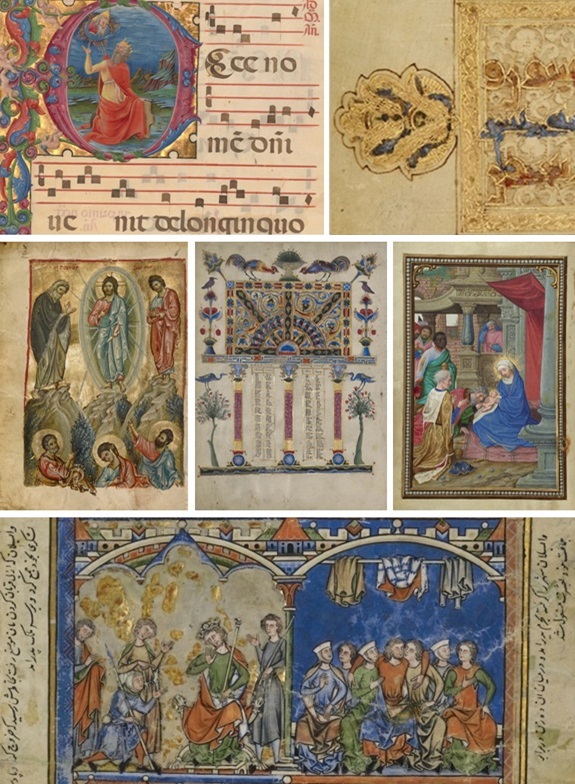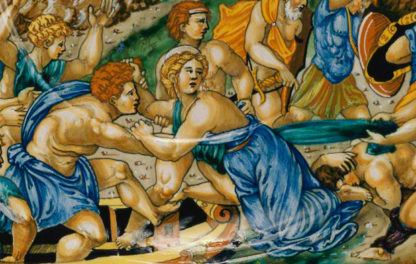
Map highlighting major centers of book use and production presented in the exhibition Traversing the Globe through Illuminated Manuscripts. Designed by Elie Glyn
The manuscripts galleries at the Getty invite you to embark on a journey around the world through the art of the book. The exhibition Traversing the Globe through Illuminated Manuscripts (January 26—June 26, 2016) explores cultural and religious exchanges, moments of encounter and exploration, and material pursuits of the premodern world as seen on the pages of books produced around the globe.
From solitary monastic sites in the Kathmandu Valley of Nepal to royal mining communities in the Southern Andes Mountains, from courtly centers in northern Europe to the scriptoria of Ethiopia, the exhibition reveals images of and ideas about the world from the 9th to the early 17th century.

The peoples of Europe, Africa, and Asia, in particular, were far more connected—through trade, travel, and religious and political engagements—than we might realize today. Rare, highly prized manuscripts and painted books produced on animal-skin parchment, paper, and palm leaf paper in Traversing the Globe allow us to glimpse, admire, and study a bygone world, its peoples, and its belief systems.

Saint John (detail), Ethiopian, late 14th-early 15th century, leaf from a Gospel Book (text in Ge’ez). The J. Paul Getty Museum, Ms. 89, verso
Global Art Histories
My initial spark for thinking in global terms about the Getty Museum’s collection—which is largely comprised of art from western Europe and the United States—was an interaction I had as an educator here almost a decade ago. After introducing a small group of visitors to a recently acquired page from an Ethiopian Gospel Book (shown above), I heard a family reading aloud what I later learned were the words penned on the parchment in Ge’ez, the liturgical language of the Ethiopian Church. The patriarch was in tears, and he exclaimed that it was wondrous to see an object embodying his cultural, linguistic, and religious heritage in a museum. This experience was deeply moving not only for the family, but for me as well.
This combination of auditory and visual engagement with art was central to us in planning the exhibition. Thanks to a group of specialists and to our digital media departments, visitors to the exhibition will be able to hear a selection of readings in historic languages from a range of manuscripts. This multi-sensorial component will also live online forever through the Getty Iris series Medieval Manuscripts Alive.

Global inspiration from the Getty permanent collection. Row 1: Gentile da Fabriano (77.PB.92); Lidded Vase (72.DI.41); Van Gogh (90.PA.20). Row 2: Roger Fenton (92.XM.53); George Trubert (Ms. 48, fol. 159); Northumberland Bestiary (Ms. 100, fol. 54). Row 3: Malnazar and Aghap’ir (Ms. Ludwig I 14, fol. 358v); Simon Bening (Ms. Ludwig IX 19, fol. 13v); Master of the Murano Gradual (Ms. 73).
Teaching with the permanent collection has since afforded me many pathways for (re)considering the global narratives possible in a museum setting. In conceiving Traversing the Globe, I drew upon two previous team-teaching experiences. My friend and former colleague Jennifer Li and I taught a four-part course at the Getty called East/West Connections that considered the relationships among artistic traditions, such as silks from the Islamic world and Italian medieval and Renaissance painting, Chinese porcelain and French and Dutch Baroque decorative arts, Japanese woodblock prints and Impressionism, and the controversial topic of Orientalism across periods and movements.
Among all these objects, it is the medieval paintings found in manuscripts that offer the earliest glimpses into a global past. They embody timeless themes of cross-cultural adaptation, inspiration, emulation, and even misrepresentation. Of course, these ideas can be explored as well at the Getty Villa in Malibu and when looking at art from earlier moments in world history, but the medieval world still represents a particularly important moment when portable artworks were created for a remarkably mobile segment of humanity across the globe. In medieval Europe, a majority of the population encountered Islamic art, for example, by entering churches or universities, through repurposed objects and motifs or through texts in translation, respectively. (And the Iberian Peninsula was, for centuries, ruled in part by Muslim caliphates)

Saint Matthew, about 1120-40, Helmarshausen, Germany, from Gospel Book. The J. Paul Getty Museum, Ms. Ludwig II 3, fols. 9v-10
More recently, manuscripts curator Kristen Collins and I led a small group of undergraduates in a seminar focused on illuminated manuscripts and the global Middle Ages. We challenged the students to think creatively and expansively about how a single object could have allowed medieval user-viewers to imaginatively “map” themselves to distant places. For example, the combination of luminous gold and silver letters against a background painted to resemble patterned purple silk (above) would have metaphorically transported the 12th-century reader of a Romanesque Gospel Book back to Imperial Rome, when the grandest manuscripts were written on parchment dyed or painted with costly Tyrian purple (a pigment made from the murex sea snail native to the Levantine coast of the Mediterranean). The geometric designs on fabrics also evoke the luxurious garments worn in Byzantium—the Eastern Roman Empire centered in Constantinople (Istanbul)—which were highly desired by Western Europeans as diplomatic gifts or smuggled commodities. Moreover, textiles often covered manuscripts or were transformed into delicate veils to shroud precious illuminations, and this practice can be observed in book arts of medieval Europe, Byzantium, and across Africa and Asia, as demonstrated in the exhibition. When teaching our course, we also benefited from the expertise of Getty manuscripts conservator Nancy Turner, whose vast knowledge on the global trade in materials used to produce book arts continues to inform our assessment of these objects.
These rich and multifaceted stories about a single object can chart global networks from Germany to the heart of Byzantium (Asia Minor), the vast Mediterranean Basin, and ultimately—with the juxtaposition of additional objects—to China via the Silk Roads. In an exhibition with some 80 objects, the connections are far greater than the word limits of gallery texts allow!

A selection of Getty manuscript pages on view in the exhibition Traversing the Globe through Illuminated Manuscripts
Kaleidoscopic Narratives
Another early goal for the exhibition was to consider the relationships between manuscripts in the Getty collection—which were primarily created in western and central Europe and major centers of the historic Byzantine world (Eastern Roman Empire)—with the wealth of contemporaneous book arts produced across Africa and Asia and which are now housed in collections across Los Angeles. The Getty objects have been arranged through a series of pairings with generous and important loans that effectively expand the geographic, artistic, and religious scope of the presentation. For these loans I am most grateful to my colleagues at the Getty Research Institute, Los Angeles County Museum of Art, the Norton Simon Museum, the Huntington Library, the Charles E. Young Research Library at UCLA, and to Mr. Robert McCarthy.
The gathering of almost 80 artworks provides a rich lens through which to view kaleidoscopic narratives about what it meant to be “global” in the periods sometimes referred to as the Middle Ages (or medieval period) and the Renaissance. Yet one of the challenges in telling an inclusive world history of any moment in time is to determine when and where to begin. Traversing the Globe through Illuminated Manuscripts looks broadly across the 9th to the 17th centuries and considers networks and connectivity rather than boundaries or isolation, geographic centers as well as peripheries.

Saint James as a Pilgrim with a Purse and Staff (detail), Workshop of the Bedford Master, Paris, about 1440-50, Book of Hours (text in Latin). The J. Paul Getty Museum, Ms. Ludwig IX 6, fol. 203v
Over the next several months here on the Iris, I will share stories, insights, and revelations about specific objects and themes of the exhibition, including (mis)conceptions about the peoples and places of Europe, Africa, Asia, and the Americas (presented at the Getty in the first gallery), and consider world maps, trade networks, and religious encounters (presented in the second gallery). I hope you will join me on this exciting journey!




I am excited to discover this exhibit. I came to LA on business this morning, and am staying at the Angeleno hotel, which I realized, only as I approached it by car today (Monday), is a very short distance from the Getty. I visited the Getty about 5 years ago. 40 years ago, I repaired old books, and studied conservation of library materials with Dr. Richard Smith at UW in Seattle. I can hardly wait for the museum to open tomorrow so that I can spend a few hours in Traversing the Globe. What a thrill!